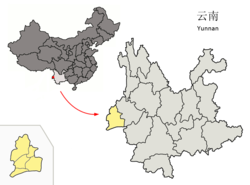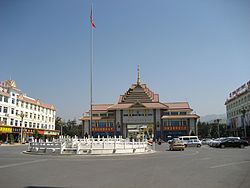Dehong
| 德宏 傣族 景頗族 自治州 Dehong |
||
|---|---|---|
|
|
||
| Coordinates | 24 ° 26 ' N , 98 ° 35' E | |

|
||
| Basic data | ||
| Country | People's Republic of China | |
| Yunnan | ||
| region | Southwest China | |
| ISO 3166-2 | CN-YN | |
| surface | 11,172 km² | |
| Residents | 1,279,000 (2015) | |
| density | 114.5 Ew. / km² | |
| Post Code | 678400 | |
| Website | www.dh.gov.cn | |
| Others | ||
| status | Autonomous District | |
| Time zone | China Standard Time (CST) UTC +8 |
|
|
Ruili Inland Port Gate
|
||
The Dehong Autonomous District of the Dai and Jingpo ( Dai : ᥖᥬᥲᥑᥨᥒᥰ, IPA [ taɯxoŋ ]; Chinese 德宏 傣族 景頗族 自治州 , Pinyin Déhóng Dǎizú Jǐngpōzú Zìzhìzhōu ) is located in the west of the Chinese province of Yunnan . Dehong has an area of 11,526 km² and around 1,294,000 inhabitants (end of 2016). The administrative seat of the capital Mang is the large municipality Mangshi ( Chin. Mángshì Zhèn芒市 镇; Dai : ᥛᥫᥒᥰᥑᥩᥢᥴ, IPA [ mə̂ŋxɔn ]), which is also known for its airport.
Administrative structure
At the county level, Dehong consists of two independent cities and three counties. These are (population figures from the end of 2003):
- City of Mang (芒市), 2987 km², 340,000 inhabitants, district capital, seat of the district government;
- City of Ruili (瑞丽 市), 1020 km², 110,000 inhabitants;
- Circle Lianghe (梁河县), km² in 1159, 160,000 inhabitants, capital: greater community Zhedao (遮岛镇);
- Circle Yingjiang (盈江县) km² 4429, 270,000 inhabitants, capital: greater community Pingyuan (平原镇);
- Longchuan District (陇川 县), 1931 km², 170,000 inhabitants, capital: Zhangfeng Municipality (章 凤 镇).
Ethnic breakdown of the population (2000)
At the 2000 census, Dehong had 1,082,599 residents.
| Name of the people | Residents | proportion of |
|---|---|---|
| Han | 548.403 | 50.66% |
| Dai | 326.260 | 30.14% |
| Jingpo | 124,822 | 11.53% |
| Achang | 26,909 | 2.49% |
| Lisu | 26,267 | 2.43% |
| De'ang | 12,870 | 1.19% |
| Bai | 6.351 | 0.59% |
| Yi | 2,845 | 0.26% |
| Hui | 2,379 | 0.22% |
| Va | 1,017 | 0.09% |
| Miao | 723 | 0.07% |
| Zhuang | 686 | 0.06% |
| Manchu | 637 | 0.06% |
| Bouyei | 572 | 0.05% |
| Naxi | 474 | 0.04% |
| Others | 1,384 | 0.12% |
See also
Individual evidence
- ↑ Wū Língyún 巫凌云, Yáng Guāngyuǎn 杨光远: Dǎiyǔ yǔfǎ《傣 语 语法》. Yúnnán mínzú chūbǎnshè 云南 民族 出版社, Kunming 1993, ISBN 7-5367-0736-3 , p. 20.
- ↑ Wū Língyún 巫凌云, Yáng Guāngyuǎn 杨光远: Dǎiyǔ yǔfǎ《傣 语 语法》. Yúnnán mínzú chūbǎnshè 云南 民族 出版社, Kunming 1993, ISBN 7-5367-0736-3 , p. 5.

